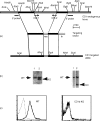Innate immune response to encephalomyocarditis virus infection mediated by CD1d
- PMID: 14632651
- PMCID: PMC1783078
- DOI: 10.1111/j.1365-2567.2003.01779.x
Innate immune response to encephalomyocarditis virus infection mediated by CD1d
Abstract
CD1d-reactive natural killer T (NKT) cells can rapidly produce T helper type 1 (Th1) and/or Th2 cytokines, can activate antigen-presenting cell (APC) interleukin-12 (IL-12) production, and are implicated in the regulation of adaptive immune responses. The role of the CD1d system was assessed during infection with encephalomyocarditis virus (EMCV-D), a picornavirus that causes acute diabetes, paralysis and myocarditis. EMCV-D resistance depends on IL-12-mediated interferon-gamma (IFN-gamma) production. CD1d-deficient mice, which also lack CD1d-reactive NKT cells, were substantially more sensitive to infection with EMCV-D. Infected CD1d knockout mice had decreased IL-12 levels in vitro and in vivo, and indeed were protected by treatment with exogenous IL-12. IFN-gamma production in CD1d knockout mice was decreased compared with that in wild-type (WT) mice in response to EMCV-D in vitro, although differences were not detected in vivo. Treatment with anti-asialo-GM1 antibody, to deplete NK cells, caused a marked increase in susceptibility of WT mice to EMCV-D infection, whereas CD1d knockout mice were little affected, suggesting that NK-cell-mediated protection is CD1d-dependent. Therefore, these data indicate that CD1d is essential for optimal responses to acute picornaviral infection. We propose that CD1d-reactive T cells respond to early immune signals and function in the innate immune response to a physiological viral infection by rapidly augmenting APC IL-12 production and activating NK cells.
Figures






Similar articles
-
CD1d mediates T-cell-dependent resistance to secondary infection with encephalomyocarditis virus (EMCV) in vitro and immune response to EMCV infection in vivo.J Virol. 2006 Jul;80(14):7146-58. doi: 10.1128/JVI.02745-05. J Virol. 2006. PMID: 16809320 Free PMC article.
-
CD1d-reactive T-cell activation leads to amelioration of disease caused by diabetogenic encephalomyocarditis virus.J Leukoc Biol. 2001 May;69(5):713-8. J Leukoc Biol. 2001. PMID: 11358978
-
Direct CD1d-mediated stimulation of APC IL-12 production and protective immune response to virus infection in vivo.J Immunol. 2010 Jan 1;184(1):268-76. doi: 10.4049/jimmunol.0800924. Epub 2009 Nov 30. J Immunol. 2010. PMID: 19949077 Free PMC article.
-
Regulation of immune responses by CD1d-restricted natural killer T cells.Immunol Res. 2004;30(2):139-53. doi: 10.1385/IR:30:2:139. Immunol Res. 2004. PMID: 15477656 Review.
-
CD1d-restricted "NKT" cells and myeloid IL-12 production: an immunological crossroads leading to promotion or suppression of effective anti-tumor immune responses?J Leukoc Biol. 2004 Aug;76(2):307-13. doi: 10.1189/jlb.0104038. Epub 2004 May 3. J Leukoc Biol. 2004. PMID: 15123775 Review.
Cited by
-
Exacerbated susceptibility to infection-stimulated immunopathology in CD1d-deficient mice.J Immunol. 2005 Jun 15;174(12):7904-11. doi: 10.4049/jimmunol.174.12.7904. J Immunol. 2005. PMID: 15944296 Free PMC article.
-
NKT cell immune responses to viral infection.Expert Opin Ther Targets. 2009 Feb;13(2):153-62. doi: 10.1517/14712590802653601. Expert Opin Ther Targets. 2009. PMID: 19236234 Free PMC article. Review.
-
Innate and cytokine-driven signals, rather than microbial antigens, dominate in natural killer T cell activation during microbial infection.J Exp Med. 2011 Jun 6;208(6):1163-77. doi: 10.1084/jem.20102555. Epub 2011 May 9. J Exp Med. 2011. PMID: 21555485 Free PMC article.
-
Adipose Natural Killer Cells Regulate Adipose Tissue Macrophages to Promote Insulin Resistance in Obesity.Cell Metab. 2016 Apr 12;23(4):685-98. doi: 10.1016/j.cmet.2016.03.002. Epub 2016 Mar 31. Cell Metab. 2016. PMID: 27050305 Free PMC article.
-
Identification of a Potent Microbial Lipid Antigen for Diverse NKT Cells.J Immunol. 2015 Sep 15;195(6):2540-51. doi: 10.4049/jimmunol.1501019. Epub 2015 Aug 7. J Immunol. 2015. PMID: 26254340 Free PMC article.
References
-
- Bendelac A, Lantz O, Quimby ME, Yewdell JW, Bennink JR, Brutkiewicz RR. CD1 recognition by mouse NK1+ T lymphocytes. Science. 1995;268:863–5. - PubMed
-
- Porcelli SA, Modlin RL. The CD1 system. antigen-presenting molecules for T cell recognition of lipids and glycolipids. Annu Rev Immunol. 1999;17:297–329. - PubMed
-
- Brossay L, Tangri S, Bix M, Cardell S, Locksley R, Kronenberg M. Mouse CD1-autoreactive T cells have diverse patterns of reactivity to CD1+ targets. J Immunol. 1998;160:3681–8. - PubMed
-
- Behar SM, Podrebarac TA, Roy CJ, Wang CR, Brenner MB. Diverse TCRs recognize murine CD1. J Immunol. 1999;162:161–7. - PubMed
Publication types
MeSH terms
Substances
Grants and funding
LinkOut - more resources
Full Text Sources
Other Literature Sources
Molecular Biology Databases

